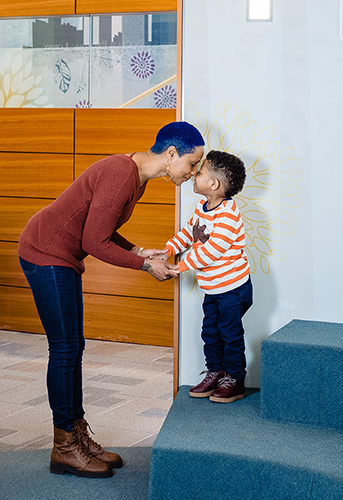Chiari Starling
Skilled Intestinal Surgery Helps 5-Year-Old Eat on His Own Despite Long Odds
Before he was even born, Chiari Starling faced a serious health issue. Doctors had prenatally diagnosed him with gastroschisis, a rare condition — affecting 3 to 4 of every 10,000 children — in which infants are born with a portion of their intestines outside of the abdomen.

Fear Then Worry
“We didn’t know the severity or the complication that it would have on his life,” said Chiari’s aunt and legal guardian, Crystal Starling.
Chiari was born on November 11, 2014 — seven weeks premature. Soon after delivery, he was taken to the operating room to have his intestines put back in his abdomen. Chiari recovered well from the surgery and remained in the hospital for about two months. During this time, Chiari’s medical team and family worked on feeding him through intravenous (IV) fluids and helping him grow appropriately.
“Our first thoughts were fear, and then worry that he was so young and tender and having to go through something like that,” Crystal recalled.
Shortly after being discharged home, Chiari was brought back to the hospital — critically ill. He was soon diagnosed with necrotizing enterocolitis (NEC), a condition that is characterized by necrosis, or death, of the intestinal tissue. NEC is another rare and life-threating condition that affects 1 to 3 babies every 1,000 births. It’s usually diagnosed in infants who are born prematurely.
Surgeon Feared His Condition Was “Incompatible With Life.”
When Chiari was taken to the operating room, the surgeon found that Chiari only had 11 centimeters of small bowel — massively below the 200-250 centimeter average for a child at birth. It was such a small amount that the surgeon remarked in his operative note that he feared it was “incompatible with life.”
In addition, Chiari faced a third diagnosis caused by NEC: ultrashort bowel syndrome (USBS), a condition where the length of bowel is less than 10 percent of what is expected for a particular age. Approximately one third of infants with USBS have died by the time they’re 6 years old. Surviving infants are faced with a 47 percent chance of their bowel being able to absorb all the nutrients it needs to live and being about to wean off the IV. Many of these patients had more bowel than Chiari.

Chiari rubbing noses with his aunt, Crystal Starling.
Given the odds, Chiari faced the strong possibility of having to continue to rely on an IV for nutrition for his entire life, which can be further complicated by serious blood stream infections, liver failure, and loss of central venous access options over time. Chiari continued to show great resilience for being so young and fragile and quickly recovered from this surgery, although he had to receive all of his nutrition through IV.
For Chiari’s family, the time he spent in the hospital was overwhelming and scary.
“At times I felt like there was no hope,” shared Crystal. “It’s a bottle of emotion.”
It seemed to be an uphill battle with no end in sight: Chiari was hospitalized 15 times in the first two years of his life with complications associated with his central line. He had suffered life-threatening infections, sepsis, and the ability to feed him was severely limited due to his inability to absorb nutrients in what was left in his intestine.
Due to the ongoing need for IV-based nutrition, he was diagnosed with intestinal failure. In an attempt to improve his condition, Derek Wakeman, M.D. assistant professor in the Department of Surgery, and Walter Pegoli Jr., M.D., chief of Pediatric Surgery, performed a serial transverse enteroplasty procedure (STEP) to surgically lengthen Chiari’s intestine when he was 10 months old. STEP is an innovative procedure that was first introduced in the medical field in 2002 and requires advanced surgical expertise. Doctors also connected the small intestine to what was left of Chiari’s colon to take advantage of the water absorption there.
Before this surgery, Chiari wasn’t allowed to stay home because of the treatment he needed, which required a tube in his stomach to suck out the contents because his intestine wasn’t working. After this surgery, Chiari was able to steadily improve with feeding and close-monitoring that required meticulous care both in and out of the hospital. He had weekly blood work, follow up phone calls, and frequent office visits.
Third Birthday
Due to the tireless efforts of the GCH caregiving team and the support of Crystal, Chiari was able to be taken off the IV and start eating regularly by his third birthday, and now he now has no tubes at all and is thriving.
“Being able to wean off total parenteral nutrition completely in such a relatively short period of time after having only 11 centimeters of small bowel left is truly remarkable,” said Wakeman. “We know that there are certain foods that can enhance the bowel’s ability to adapt after massive bowel resection. I think this is a testament to the intestinal failure team and his family for really encouraging him to eat a variety of healthy foods.”
 “Here at Golisano Children’s Hospital we are privileged to be able provide advanced care for patients with intestinal failure,” said Megan Gabel, M.D., assistant professor in the Division of Pediatric Gastroenterology, Hepatology and Nutrition, who was involved in his care. “We have all of the key elements needed to consistently deliver optimal care for these children. A strength of our program is the multidisciplinary team that finds joy in treating complex patients like Chiari.”
“Here at Golisano Children’s Hospital we are privileged to be able provide advanced care for patients with intestinal failure,” said Megan Gabel, M.D., assistant professor in the Division of Pediatric Gastroenterology, Hepatology and Nutrition, who was involved in his care. “We have all of the key elements needed to consistently deliver optimal care for these children. A strength of our program is the multidisciplinary team that finds joy in treating complex patients like Chiari.”
Both doctors and Chiari’s family credit his survival to the “village of providers” that helped care for him. From staff to nurses, social workers, dieticians, physicians, and most importantly his family.
“I couldn’t ask for a better team to have worked with,” said Crystal.
Chiari does have some lifelong effects from his conditions and treatment. His left leg is a little longer than his right leg because of a complication with blood flow during his hospitalization. But he recently got a “lift” for his shoe and wears a brace when he’s active, and when you ask Crystal how he’s doing now, she’s quick to respond, “Excellent!”
The one thing he loves to do most? Eat. “From sun up to sun down,” says Crystal. Chiari also enjoys writing, reading and music, and engaging in the general silliness of a being a young boy: “He likes to dance and loves gorillas. He thinks he’s King Kong and talks about going to the moon every day,” says Crystal, “whatever he does, I hope he leaves a positive impression.”
He has certainly left a positive impression on his medical team at Golisano Children's Hospital.